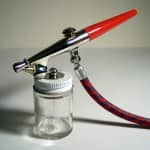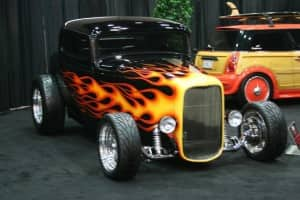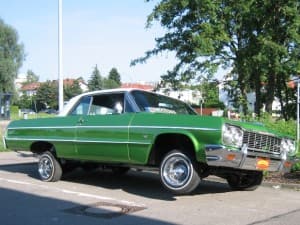Some artists prefer paper, others canvas or wood. But for those wielding an airbrush, sheetmetal is ideal. Despite its seeming like a relatively recent movement, airbrushing artwork on vehicles has been around for over half a century. And for those car, truck and motorcycle enthusiasts looking for the ultimate in expressing themselves through their ride, it's hard to top a custom airbrush graphic or mural.
The Early Days of Airbrushing
 According to some historians, the first fully functional airbrush was invented by Charles Burdick, who, via Thayer and Chandler Art Materials company, presented his small paint spraying device at the 1893 Chicago World's Fair. The basic design still continues to this day, and consists of pressurized air that runs through a venturi, creating suction that pulls paint in from a reservoir and atomizes it into tiny droplets. The resulting fine spray of paint can be precisely released and controlled via a trigger on the sprayer and used to provide the artist's most minute detail.
According to some historians, the first fully functional airbrush was invented by Charles Burdick, who, via Thayer and Chandler Art Materials company, presented his small paint spraying device at the 1893 Chicago World's Fair. The basic design still continues to this day, and consists of pressurized air that runs through a venturi, creating suction that pulls paint in from a reservoir and atomizes it into tiny droplets. The resulting fine spray of paint can be precisely released and controlled via a trigger on the sprayer and used to provide the artist's most minute detail.
When car customizing really started to take hold in the 1950s, having a "flame job" done to the front of a car was about the coolest thing a hot rodder could do to jazz up his ride's looks. Back then, nothing gave off the impression of potential speed like flames igniting and spreading out over the front of the car.

If the van's rocking, don't come knocking
Airbrushing seemed to reach its zenith in the 1970s with the custom van movement. In addition to their love den interiors outfitted with huge beds, wood paneling and plenty of deep shag carpeting, these massive, nearly windowless boxes on wheels provided the perfect blank canvas thanks to their large expanses of flat sheetmetal.
Wolves howling at the moon, dragons soaring through the air, and Sorcerers doing their thing were popular van art themes of the time. Some were literally out of this world as they depicted Star Trek or Star Wars scenes, as well as moonscapes and other extra-terrestrial visions.
This era also saw low riders hitting their stride and getting artsy. Typically an early-mid 1960s American car, a low rider was exactly as its name implied with its suspension lowered to the point of the car nearly scraping the pavement. More modern versions use adjustable air or hydraulic suspensions. These allow the driver to raise the car up for normal driving, slam it to the ground for "low and slow" cruising or even rapidly raise and lower the car to the point of hopping around. Chevy Impalas are usually the vehicle of choice here, and the airbrushed graphics typically depict a beautiful, scantily-clad Latina on the hood or trunk.
Dude, those are some sick graphics
In addition to those classic themes, modern day graphics -- as with much of the clothing and jewelry nowadays -- seem to have a preoccupation with skulls. The variety of these "boneheads" won't be denied as they range from whimsical to downright scary. There are also paint schemes that pay homage to certain ethnicities. And flames haven't gone out of style either, with "ghost" flames -- those usually done in a slightly lighter or darker shade of the car's primary color -- being quite popular.
Getting ink…we mean paint…done
If you're looking to customize your ride with airbrushed art, you have plenty of options as even a cursory Google search brings up plenty of talented artists and samples of their work. Should you be artistically inclined and want to give a go yourself, you can take a class or even get tutored via YouTube. The Airbrush Museum site is a good source for all things airbrushing.









